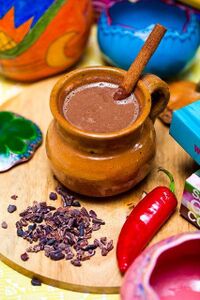Mutulese Chocolate
This article is incomplete because it is pending further input from participants, or it is a work-in-progress by one author. Please comment on this article's talk page to share your input, comments and questions. Note: To contribute to this article, you may need to seek help from the author(s) of this page. |

Chocolate, (Mutli: "Kakaw") is produced all throughout the Mutul, in quantities between 9,000 and 20,000 tons of tablets and 9 - 10 millions of bottles per year. The Divine Kingdom is the largest producer of liquid chocolate in the world, and one of the two largest exporters of cacao alongside Sante Reze. Chocolate is almost cosubstantial with the country, as traces of chocolate beverages and vessels associated to its consommation can be found even in the oldest archeological sites. It is supposed that the cultivation of the cacao tree was brought north from the Ucayare forest by nomadic populations of agro-forester. The chocolate produced range from expensive chocolates sold internationally to modest creations usually only seen within the Divine Kingdom.
Two concepts central to the better Mutuleses chocolates are the Nal, which links the style of the chocolate to the locations where the cacao are grown and transformed. The second is the Divine Mark that certifies the origin and the quality of the chocolate. The rules of the attribution of the Divine Mark closely define which cacao varieties and transformation practices are approved for classification in each of the Mutul's 75 000 exploitations. These rules only cover the production and distribution of liquid chocolate, chocolate tablets and "solid chocolate" do not show the same level of regulation, as they are not considered socially to be as prestigious.
History
Early days
Evidence suggest that the cacao tree was first cultivated by humans for its pods' sweet pulp. Fermented, it was served as an alcoholic beverage in the Mutul since 1400 BCE. The first real evidences of the culture of cacao are from Sante Reze, and date back to more than 5000 years ago.
Depiction of offerings of cacao to the gods or to mortal rulers during the Paol'lunyu Dynasty show that it was the kakaw drink that was used for exchanges, not yet to cocoa beans themselves.
Cocoa bean as money
Styles, varieties, and Kakawnal
Kakawnal
The Mutul possess many "Kakawnal", agricultural plantations dedicated to the cultivation of the cacao trees (Mutli: Kakaw T'e). Each has soils, practices, and an history characteristic of the parcel. It's on these specificities that the "Nal" is defined.
For the chocolate industry, the "Nal" refers to the unique combination of natural factors such as soil, underlying rock, altitude, terrain, and microclimate. It is an important factor, alongside the cultivar of chocolate, being measured in the Certification system which guarantees the origin and quality of the production.
varieties
Historically, chocolate makers have recognized three main cultivar groups of cacao beans used to make cocoa and chocolate: Forastero, Criollo and Trinitario. The most prized, rare, and expensive is the Criollo group, the historical cocoa bean of the Mutul. Worldwide, only 10% of chocolate is made from Criollo, which is arguably less bitter and more aromatic than any other bean. In the Mutul, it is up to 80%. Outlying cacao producers who aren't located in the natural biome of the cacao tree still prefer other varieties that are more resistant to diseases and weathers and have higher yields. Since the 2000s, these producers have shifted en-masse to Trinitario, an hybrid between Forastero and Criollo supposed to preserve the qualities of both.
Productions
New processes that speed the production of chocolate emerged early in the Industrial Revolution, which the Mutul never adopted as it retained its traditional preference for chocolate as a drink and not as solid food. As such what comes out of the cacao mills is raw Chocolate liquor, and sometime block of Raw chocolate, for transport.
Raw chocolate is then sent from the mill to the factory proper. Each factory has its own recipe, many of which are protected by labels and certificates delivered by the Divine Throne.